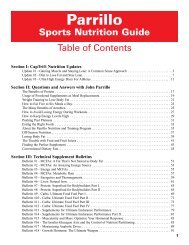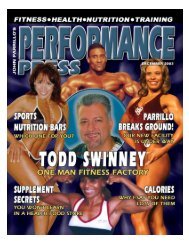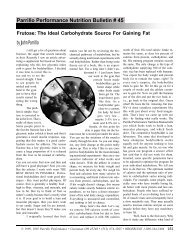A Monthly Magazine For All Bodybuilding, Fitness And - Parrillo ...
A Monthly Magazine For All Bodybuilding, Fitness And - Parrillo ...
A Monthly Magazine For All Bodybuilding, Fitness And - Parrillo ...
You also want an ePaper? Increase the reach of your titles
YUMPU automatically turns print PDFs into web optimized ePapers that Google loves.
Hardgaining Bodybuilders<br />
Priority Routines for Bringing up<br />
Stubborn Body Parts<br />
by Ron Harris<br />
Do you have any weak body parts?<br />
Unless your name is Ronnie Coleman<br />
or Flex Wheeler, you have a muscle<br />
group or two that lags behind the rest.<br />
We all have body parts that do not seem<br />
to respond no matter what exercises we<br />
try and no matter how much intensity<br />
we pour into them. Many trainees will<br />
simply throw in the towel, declaring with<br />
grim resolve that “my calves will never<br />
grow” or “this is about as big as my<br />
triceps will ever get.” We come up with<br />
a litany of excuses/explanations for this<br />
sorry situation and blame everything<br />
from inferior genetics to poor blood flow<br />
for our muscular woes. Is this depressing<br />
death sentence final? It certainly appears<br />
so to us. You may have tried all<br />
manner and type of intensity techniques,<br />
used exotic routines and wild<br />
rep schemes, yet in the end were left<br />
with the same lagging body part still as<br />
underdeveloped and unchanged as ever<br />
- despite all your pain and effort. One<br />
thing you may not have tried, however,<br />
is one strategy that is nearly guaranteed<br />
to bring up any stubborn body<br />
part. Magic? Voodoo? Implants? Not<br />
hardly, I’m talking about a remedy as<br />
old as the hills. It called “muscle<br />
prioritization”.<br />
A prioritization routine entails devoting<br />
far more time and energy to the<br />
problem body part than ever before. You<br />
may have tried your own version of this,<br />
but you most likely went wrong in maintaining<br />
your current volume of training<br />
for the rest of your body. When you<br />
use prioritization you have to reduce the<br />
remaining training volume. Why? Unfortunately,<br />
the human body has only a<br />
finite degree of stamina. To go beyond<br />
the limits and expect growth simply isn’t<br />
realistic or possible for the majority of<br />
trainers. If more were better, the best<br />
results would be obtained by training<br />
every day for every waking minute, day<br />
and night. Before you get the mistaken<br />
notion that I’m headed off on some sort<br />
of Mentzer-ish, Heavy-Duty minimalist<br />
trip - fear not. I’m simply suggesting<br />
that you cannot focus on every muscle<br />
group at the same time with maximum<br />
intensity. It just isn’t possible. What<br />
has worked for many bodybuilders and<br />
weight trainers is to focus in on one, or<br />
at most two, lagging body parts at a<br />
time. This is called a body part specialization<br />
routine.<br />
While prioritizing lagging parts the<br />
other muscles will take a back seat and<br />
receive only cursory work for maintenance<br />
purposes. That sounds simple<br />
and logical but most of us are too terrified<br />
of losing ground to implement such<br />
a plan. The thought of doing a couple<br />
sets a week for our stronger body parts<br />
seems suicidal. After all, won’t they<br />
shrivel up while we’re busy banging<br />
away on the stubborn body part? No<br />
they won’t – trust me. <strong>And</strong> unless you<br />
undertake some sort of prioritization you<br />
are willingly condemning the lagging<br />
muscle group to permanent mediocrity.<br />
Are you ready to try something radical<br />
in an effort to even out weak muscle<br />
groups? If so, remember that a<br />
prioritization routine lasts for only a brief<br />
time period, perhaps six to ten weeks at<br />
most. By then you will have produced<br />
some impressive gains in the previously<br />
uncooperative muscle. Then you resume<br />
your normal routine - or focus in<br />
on another lagging muscle or muscle<br />
group.<br />
Let’s get into some specific training<br />
splits for various body parts that<br />
will serve as a guide and allow target<br />
muscles the training time and recuperation<br />
they need in order to grow.<br />
Note that the “problem” body part<br />
is worked fresh after a complete day of<br />
rest. This will allow you to hammer it<br />
into oblivion with more energy and concentration<br />
than you have (probably)<br />
ever devoted to it. The hardest part of<br />
these routines is psychological: a concern<br />
that the reduction in volume in<br />
your other body parts will have a detrimental<br />
effect on them. Believe me when<br />
I assure you that they will not suffer<br />
during this very short term of reduced<br />
attention. I have gone weeks without<br />
doing more than two or three sets a week<br />
for my quads, for example, and lost not<br />
a bit of size or strength. Your strong<br />
body parts don’t need much attention.<br />
Giving them only cursory work for the<br />
duration of the prioritization routine is<br />
essential to the success of this program.<br />
It allows for extra energy reserves and<br />
this extra energy is applied to your stubborn<br />
body part. Focus and extra work<br />
will be the mitigating factor that will force<br />
growth. It’s time to get excited people,<br />
because what was once a lagging body<br />
part that was never going to grow again<br />
is about to get a new lease on life. A<br />
symmetrical physique can indeed be<br />
yours – if you have the courage to try a<br />
prioritization routine. Happy gains!<br />
Ron Harris is available for consultation.<br />
Contact him at<br />
RHarrisMSL@aol.com.<br />
24 John <strong>Parrillo</strong>’s Performance Press • June 2000 Orderline: 1•800•344•3404

















